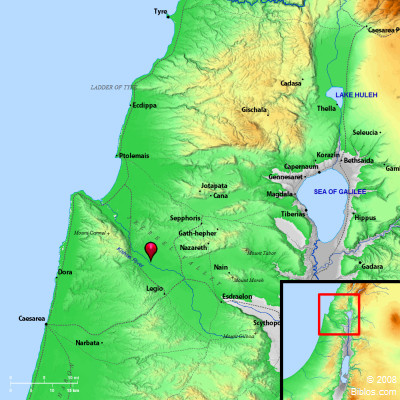Atlas  Kishon River and surrounding region Maps Created using Biblemapper 3.0 Additional data from OpenBible.info Occurrences Judges 4:7 I will draw to you, to the river Kishon, Sisera, the captain of Jabin's army, with his chariots and his multitude; and I will deliver him into your hand.'"Judges 4:13 Sisera gathered together all his chariots, even nine hundred chariots of iron, and all the people who were with him, from Harosheth of the Gentiles, to the river Kishon. Judges 5:21 The river Kishon swept them away, that ancient river, the river Kishon. My soul, march on with strength. 1 Kings 18:40 Elijah said to them, "Seize the prophets of Baal! Don't let one of them escape!" They seized them. Elijah brought them down to the brook Kishon, and killed them there. Encyclopedia KISHONki'-shon, kish'on (qishon; Keison): The "watercourse" or "torrent stream" along the banks of which the great battle was fought between Israel, led by Deborah and Barak, and the army of Sisera, in the waters of which so many perished (Judges 4:7, etc.). It is probably mentioned earlier as "the brook that is before Jokneam" (Joshua 19:11; see JOKNEAM). It appears again as the scene of Elijah's slaughter of the prophets of Baal (1 Kings 18:40). "The torrent" paragraph excellence in the district is the modern el-MuqaTTa`, a stream which drains all the plain of Esdraelon to the West of the watershed-a line drawn from Iksal to Nain, and thence to el-Fuleh and Zer`in. All the water East of this line, from the Nazareth hills, Tabor and Little Hermon, flows down Wady esh-Sherrar and Nahr Jalud into the Jordan. The Kishon collects the streams from the western slopes of Gilboa in the rainy season; and the water from the strong spring at Jenin. Contributions also come from the copious fountains in the neighborhood of Megiddo. At Sa`adiyeh, again, some 3 miles East of Chaifa, its volume is largely increased by springs rising at the base of Carmel, on the edge of the plain of Acre. From Jenin in the Southeast, the deep torrent bed follows a westerly direction, with numerous. windings cutting the plain in two, until it reaches the pass at the northeastern base of Carmel. Through the gorge between the mountain and the hills of Galilee it reaches the plain of Acre. From Sa`adiyeh it flows in a deep sluggish stream through the marsh-land to the sea near Chaifa. In this part the crocodile is said to have been seen at times. KI'SHON, a river, at the n. base of Mt. Carmel. The part near the Mediterranean is perennial, fed by springs on Mt. Carmel. Now Nahr el Mukutta; its mouth is 71 ms. from Jerusalem, It drains the valley, of Esdraelon, see Jezreel. Strong's Hebrew H7028: Qishona wadi in the plain of Megiddo |



